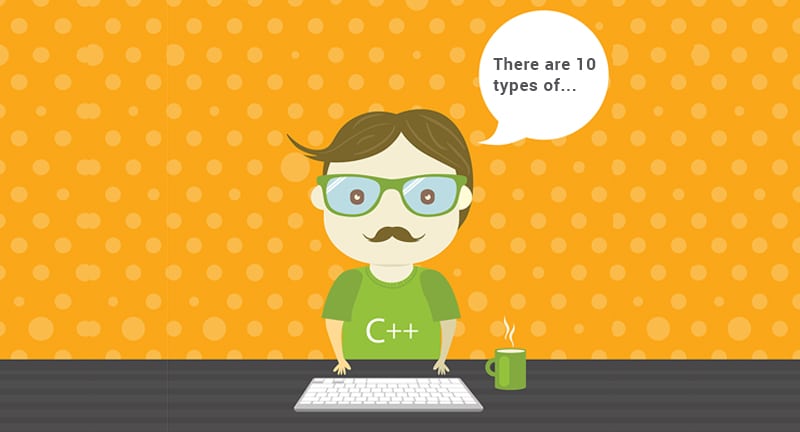Top 5 Developer Jokes Explained (Because We Don’t Get Them Either)


A sense of humor is one of the most important human qualities and that it is not only good for your health physically and emotionally, but it also reinforces your relationships with your family, friends, and coworkers.
It isn’t easy being a developer. They code all day, debug all night and go through thousands of code lines trying to clear up all possible messes before going live with their products. Sometimes, it takes a fellow programmer to understand the hardships of another programmer. They can be a bit cagey, and most are quite opinionated in their own sort of way. But when a developer says something, it more often than not, it means something entirely different from their perspective. The same can be said of their jokes.
Ahhhh…programmer humor! Hilarious to coders and completely baffling to the rest of us.
We interrogated some of our developers to get a better understanding of the best jokes that showcase a developer’s sense of humor. Don’t worry if you don’t get all of them — we have you covered. Even some of our developers got in the fun as you can see above. Without further ado, here are the Top 5 developers jokes that will help you fit in with your team of developers.
1. There are 10 types of people in this world. Those who understand binary and those who don’t.
This is a binary joke; binary being a base-2 system. Since it is a base-2 system, it has only 2 digits, 0 and 1. If we convert binary 10 to decimal, we get: 1 * 21 + 0 * 20 = 1 * 2 + 0 = 2. So, the joke means “There are two types of people. Those who understand binary and those who don’t.” If you don’t understand binary though, you’d think there are ten types of people, which would be weird. In addition to decimal (base-10), octal (base-8) and binary (base-2), hexadecimal (base-16) is also used commonly in programming. It uses the letters A, B, C, D, E, and F as the “digits” above 9.
2. There are two ways to write error-free programs; only the third one works.
This joke refers to the fact that it is actually impossible to write an error-free program.
It is possible to write a program that seems to have no errors, usually referred to as “bugs” in programmer lingo, but usually there is always one more bug. The bug may be so tiny and under such specific conditions that you’ll never see it… but there is always one more bug.
Since there is always one more bug, the joke says only the third, non-existent method is the only way to write an error-free program.
3. A good programmer is someone who always looks both ways before crossing a one-way street.
This joke refers to the fact that, as a programmer, you can’t make assumptions about how things will behave in your program and always have to check everything. Their only certainty is uncertainty.
For example, if you ask a user to type in a number, a good programmer won’t just assume what the user entered is a number. They need to check that what they got is actually a number and not a word or symbol or was left blank. Then, they need to check to make sure that the number is within the range that they were expecting (for example, -3 wouldn’t be a valid value for “How many people are attending?”).
Thus, the joke refers to the fact that they programmer can’t just assume because the road is one-way that everyone is going to follow that rule.
4. Debugging: Removing the needles from the haystack.
Debugging is the process in which you remove bugs from your program. Since finding bugs (and their causes) can frequently be tricky, finding them is like finding a needle in a haystack.
So, debugging is like removing the needles from a haystack (your program).
5. Why do programmers always mix up Halloween and Christmas? Because Oct 31 = Dec 25.
The joke here is that Octal 31 (which abbreviated looks like October 31st, Halloween) is equal to Decimal 25 (which abbreviated looks like December 25th, Christmas).
Decimal and octal are two number systems with different bases.
Decimal is the base-10 number system that everyone is familiar with. A number system has as many digits as its base number. When you get to a number that is higher than the highest digit, you add another column to the left, so you count like 8, 9, 10, 11, 12, and so on.
Octal (from the Latin root oct- meaning eight) is a base-8 number system commonly used in programming. A base-8 system means it has 8 digits (0, 1, 2, 3, 4, 5, 6, and 7). When you get to a number higher than 7, you also add another column, so you count like 6, 7, 10, 11, 12, and so on.
If we convert the Octal 31 to decimal, we end up with 25. Watch: if we break octal 31 out to a math equation, it ends up being 3 x 81 + 1 x 80 = 3 x 8 + 1 x 1 = 24 + 1 = decimal 25.
As much as I hope you enjoyed this article, we are certain there are many more ingenious programming jokes that I failed to include in this list. So, I encourage you to share your favorite picks with us.
